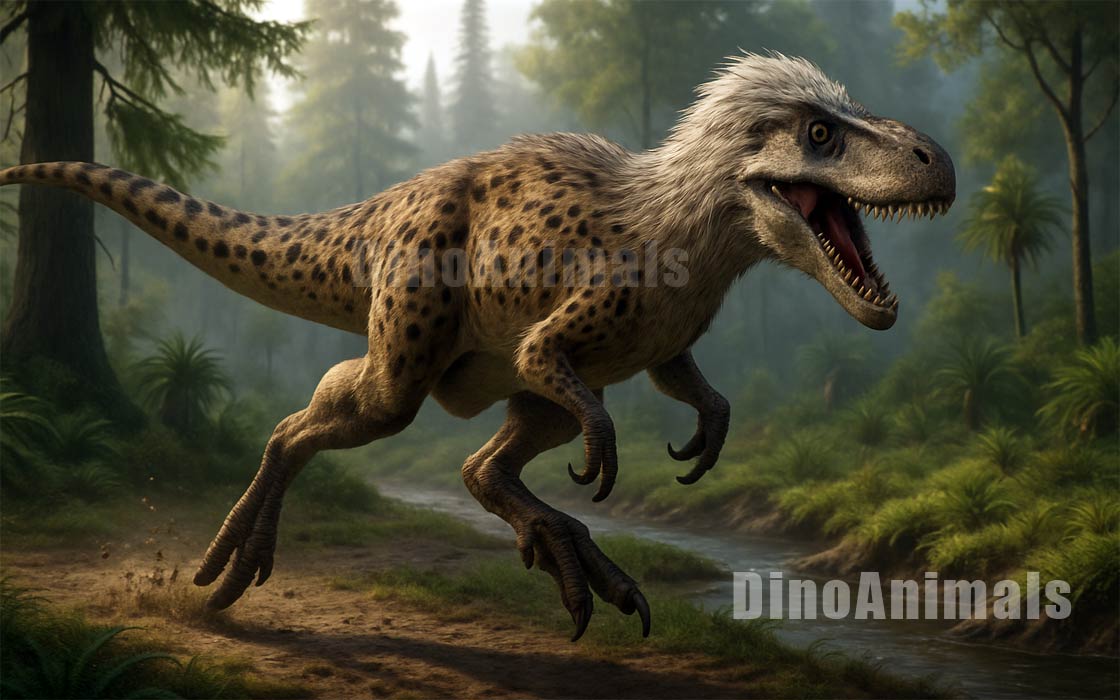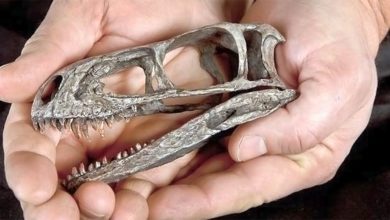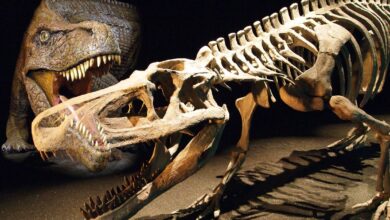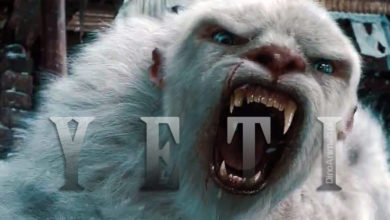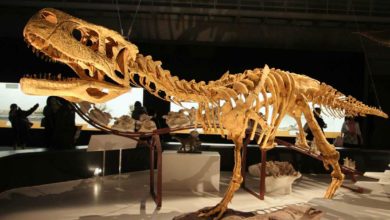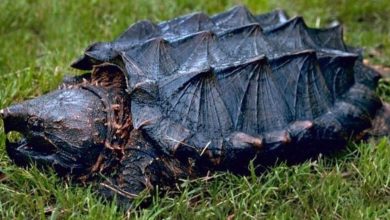Nanotyrannus and T. rex
Nanotyrannus – the “little tyrant” that wasn’t a young T. rex
Imagine the forests and swamps of 67 million years ago. Among ferns and cypresses darts a predator the size of a large horse – narrow-snouted, long-legged, with relatively long, clawed forearms. For decades it was thought to be a juvenile Tyrannosaurus rex.
Today, however, mounting evidence suggests it was a distinct genus – Nanotyrannus (“little tyrant”) – sharing its world with the Cretaceous king himself. And new research from 2025 has finally settled the debate.
Origins of the little tyrant
The story of Nanotyrannus began in 1946, when paleontologist Charles Gilmore described a skull discovered in the Hell Creek Formation of Montana (specimen CMNH 7541). He assigned it to Gorgosaurus lancensis.
It was not until 1988 that Robert Bakker and colleagues proposed a new genus, Nanotyrannus lancensis. From that moment a decades-long discussion began: was it truly a separate predator, or merely a teenage T. rex?

A turning point – October 2025
In 2025, Nature published a paper by Lindsay Zanno and James Napoli, based on an almost complete skeleton from Montana (specimen NCSM 40000), found in 2021 near the town of Jordan, USA.
Exceptionally well-preserved, the skeleton allowed scientists to study growth and maturity in unprecedented detail. The results were groundbreaking.
Nanotyrannus was an adult
Histological analysis of the bones – studying their microscopic structure – revealed 25 lines of arrested growth in the femur. This indicates an age of at least 14 years. The presence of an External Fundamental System (EFS) at the outer cortex showed that growth had ceased.
It was therefore not a “teenage” T. rex but a mature individual of a smaller species.
No transitional forms
Researchers examined more than 200 specimens of tyrannosauroids (Tyrannosauroidea) from the Late Cretaceous and found no intermediate forms between the slender Nanotyrannus and the massive Tyrannosaurus rex.
If the two represented growth stages of the same species, such intermediates should exist – but they do not.
Two species of the “little tyrant”
Zanno and Napoli concluded that the genus Nanotyrannus included two species:
- Nanotyrannus lancensis – smaller (5–6 m / 16–20 ft long, up to 700 kg / 1 500 lb), represented by CMNH 7541 and NCSM 40000;
- Nanotyrannus lethaeus – somewhat larger (up to 7 m / 23 ft, 1 200–1 300 kg / 2 600–2 900 lb), represented by the specimen “Jane” (BMRP 2002.4.1).
The species name lethaeus comes from the mythic river Lethe – the river of forgetfulness – a nod to how this specimen was long “forgotten” as a mere young T. rex.

What did Nanotyrannus look like?
In appearance it resembled a slender version of T. rex: a narrower skull, more teeth (about 25 per mandible), longer forearms (up to 20 % of femur length), and proportionally longer legs – traits that likely made it a fast runner.
Key anatomical differences
| Feature | Nanotyrannus | Tyrannosaurus rex | Biomechanical / ecological notes |
| Body length | 5–7 m (16–23 ft) | 12–13 m (39–43 ft) | Nanotyrannus was less than half the length and far lighter – a mid-sized predator. |
| Body mass | 700–1 300 kg (1 500–2 900 lb) | 7 000–12 000 kg (15 000–26 000 lb) | Lower mass allowed greater agility and acceleration. |
| Skull | slender, elongated (≈ 90 cm / 3 ft), densely toothed | broad, massive (≈ 1.5 m / 5 ft) | Nanotyrannus adapted for rapid strikes; T. rex for bone-crushing power. |
| Teeth per mandible | ≈ 17 each side (34 total) | ≈ 12 each side (24 total) | Denser dentition suited for slicing flesh, not breaking bone. |
| Total teeth | ≈ 68–70 | ≈ 58 | Nanotyrannus had thinner, longer teeth; T. rex shorter, broader, more robust. |
| Tooth shape | slender, chisel-like, lightly serrated | massive, strongly serrated, crushing | Reflects different diet and bite mechanics. |
| Forelimbs | relatively long (≈ 20 % of femur length) | very short (≈ 12 %) | Nanotyrannus may have grasped prey; T. rex had limited reach. |
| Femur length | ≈ 70 cm (2.3 ft) | ≈ 130 cm (4.3 ft) | Limb proportions indicate cursorial (running) adaptation. |
| Leg build | light, suited for speed | heavy, load-bearing | Nanotyrannus could reach 40–50 km/h (25–31 mph); T. rex 25–30 km/h (16–19 mph). |
| Bite force | ≈ 15 000–20 000 N (2 200–2 900 psi) | ≈ 57 000 N (8 300 psi) | T. rex ranks among the strongest biters in vertebrate history; Nanotyrannus relied on speed and precision. |
| Likely diet | juvenile hadrosaurs, pachycephalosaurs, small ornithopods | large hadrosaurs, ceratopsians, carrion | Distinct niches reduced competition. |
| Hunting strategy | active pursuit, ambush, possibly pack hunting | solitary predator or opportunistic scavenger | Ecological analogy: leopard (Panthera pardus) vs lion (Panthera leo). |
The anatomy suggests Nanotyrannus hunted small, agile prey – juvenile hadrosaurs, pachycephalosaurs, or small ornithopods.
Life in the shadow of the king
During the Late Cretaceous, the Hell Creek Formation (Montana, North and South Dakota) hosted an ecosystem where:
- Tyrannosaurus rex – a massive apex predator – hunted Triceratops and Edmontosaurus;
- Nanotyrannus lancensis – smaller, swift, solitary hunter;
- Nanotyrannus lethaeus – slightly larger, possibly cooperative in packs.
Their relationship may have mirrored that of modern lions (Panthera leo) and leopards (Panthera pardus): related predators occupying different niches.
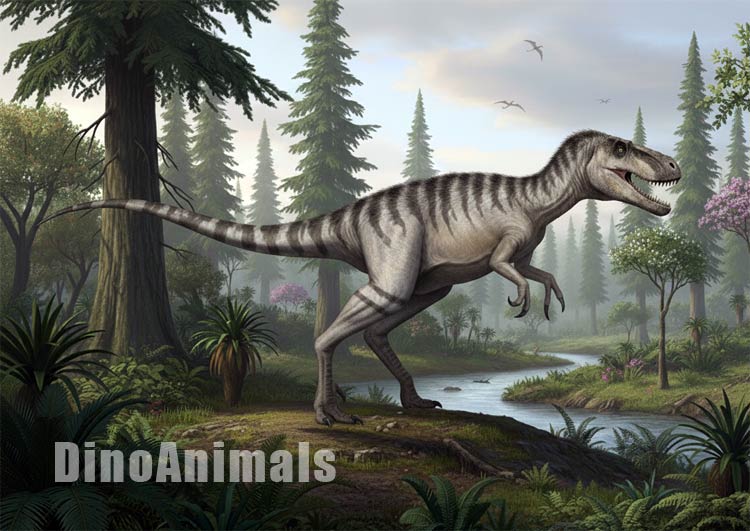
Why this discovery matters
- The end of the “young T. rex” myth – many previous growth studies of T. rex will need revision, as they included misidentified Nanotyrannus specimens.
- Greater predator diversity – just before the end of the Cretaceous, North America hosted at least three tyrannosauroid genera.
- New questions – did Nanotyrannus hunt in groups? Did it compete with T. rex for food or avoid confrontation entirely?
Where to see Nanotyrannus
None are in Poland, but key specimens can be seen in the United States:
- CMNH 7541 – Cleveland Museum of Natural History, Ohio
- NCSM 40000 – North Carolina Museum of Natural Sciences (being prepared for display)
- “Jane” (BMRP 2002.4.1) – Burpee Museum of Natural History, Rockford, Illinois
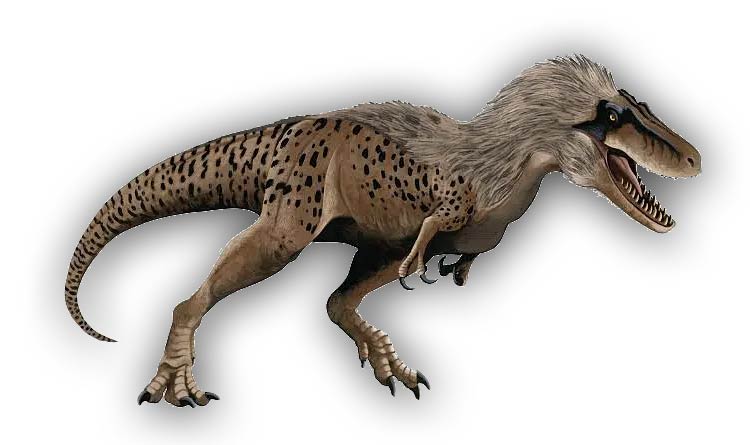
The most important Nanotyrannus specimens
CMNH 7541 – “holotype” of Nanotyrannus lancensis
Discovered in 1946 in Montana. A small, well-preserved 57 cm (1.9 ft) skull originally identified by Charles Gilmore as Gorgosaurus lancensis. In 1988 Robert Bakker and colleagues declared it the type specimen of the new genus Nanotyrannus.
BMRP 2002.4.1 – “Jane”
Found in 2001 in Carter County, Montana, by a team from the Burpee Museum of Natural History. Nearly complete skeleton of a subadult – 6.3 m (20.7 ft) long, about 1 100 kg (2 400 lb).
For years considered a juvenile T. rex, “Jane” was reclassified by Zanno and Napoli (2025) as Nanotyrannus lethaeus.
The name lethaeus refers to the mythic river Lethe – the “river of forgetfulness” – symbolizing the specimen’s long-misunderstood identity.
NCSM 40000 – “Bloody Mary”
Discovered in 2021 near Jordan, Montana, by the North Carolina Museum of Natural Sciences team. The most complete known Nanotyrannus skeleton, including skull, limbs, vertebrae, and tail.
Osteohistological analysis shows the individual was about 14 years old and fully mature, displaying an EFS (External Fundamental System) confirming growth cessation.
It was “Bloody Mary” that formed the basis of the 2025 Nature study by Zanno and Napoli, which confirmed Nanotyrannus as distinct from Tyrannosaurus.
Summary
Nanotyrannus was not a “mini T. rex” but a separate, specialized predator sharing the Late Cretaceous ecosystem with the king himself.
The 2025 discoveries by Zanno and Napoli opened a new chapter in tyrannosauroid history and reminded us that the world of dinosaurs was far more complex than once thought.
“It’s like discovering that the wolf (Canis lupus) and the coyote (Canis latrans) aren’t different-sized versions of the same animal – they’re two distinct predators living side by side.”
– Lindsay Zanno
Sources:
- Zanno, L.E., Napoli, J.G. (2025). Nanotyrannus and Tyrannosaurus coexisted at the close of the Cretaceous. Nature.
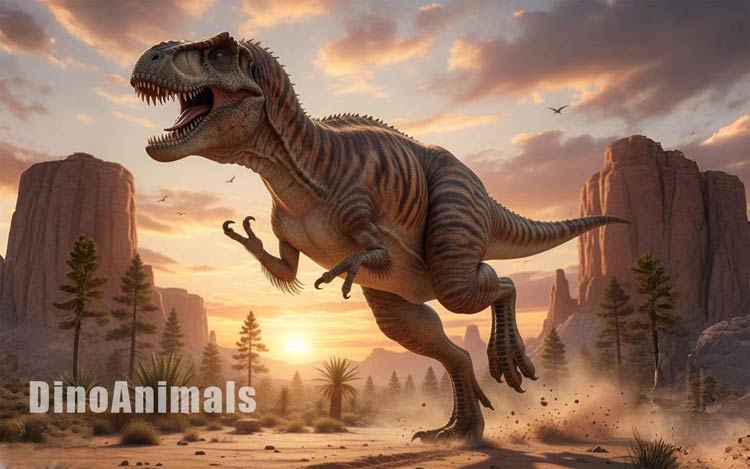
Recommended
- Megalosaurus
- The Bone wars
- Tyrannosaurs – Birth, Reign and Twilight
- Mary Anning
- Alamosaurus – one of the largest dinosaurs
- The longest dinosaurs. Sauropods Top 10
- The heaviest dinosaurs – Top 10
- The longest predatory dinosaurs. Theropods Top 10
- The heaviest predatory dinosaurs Top 10
- The longest Ornithischians (Ornithischia) TOP 10
- The heaviest Ornithischians Top 10
- The largest raptors (dromaeosaurs) Top 10
- The heaviest Dromaeosaurids / dromaeosaurs – Top 10
- The longest Ankylosaurus Top 10
- The heaviest Ankylosaurus Top 10
- The longest ceratopsians
- The heaviest ceratopsians
- The longest and largest ornithopods
- The heaviest ornithopods Top 10
- The longest Stegosaurians (Stegosauria) TOP 10
- The heaviest Stegosaurians (Stegosauria) Top 10
- The smallest sauropods Top 10
- The smallest dinosaurs Top 10
- The largest pterosaurs Top 10
- Dinosaurs
- Dinosaurs database
- Predatory dinosaurs

